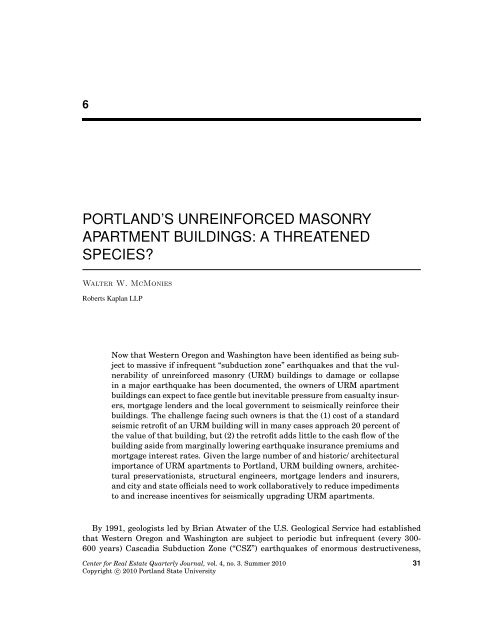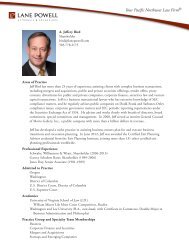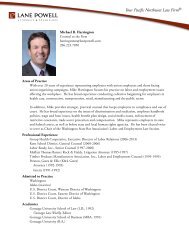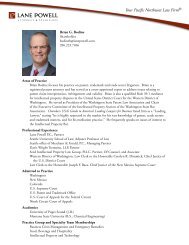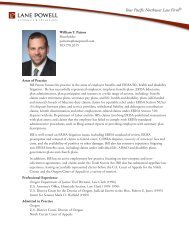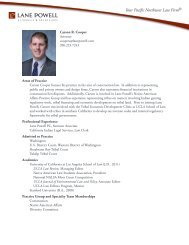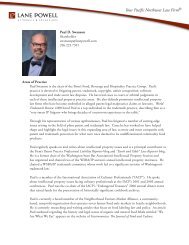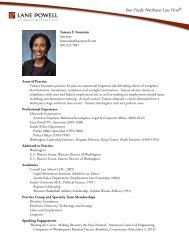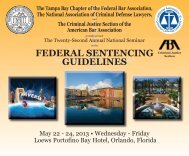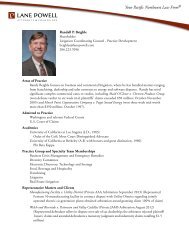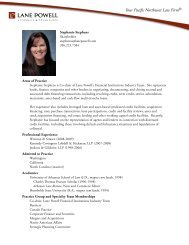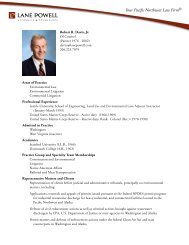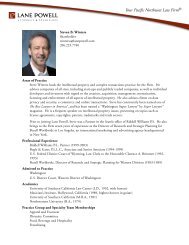portland's unreinforced masonry apartment buildings
portland's unreinforced masonry apartment buildings
portland's unreinforced masonry apartment buildings
Create successful ePaper yourself
Turn your PDF publications into a flip-book with our unique Google optimized e-Paper software.
6<br />
PORTLAND’S UNREINFORCED MASONRY<br />
APARTMENT BUILDINGS: A THREATENED<br />
SPECIES?<br />
Walter W. McMonies<br />
Roberts Kaplan LLP<br />
Now that Western Oregon and Washington have been identified as being subject<br />
to massive if infrequent “subduction zone” earthquakes and that the vulnerability<br />
of <strong>unreinforced</strong> <strong>masonry</strong> (URM) <strong>buildings</strong> to damage or collapse<br />
in a major earthquake has been documented, the owners of URM <strong>apartment</strong><br />
<strong>buildings</strong> can expect to face gentle but inevitable pressure from casualty insurers,<br />
mortgage lenders and the local government to seismically reinforce their<br />
<strong>buildings</strong>. The challenge facing such owners is that the (1) cost of a standard<br />
seismic retrofit of an URM building will in many cases approach 20 percent of<br />
the value of that building, but (2) the retrofit adds little to the cash flow of the<br />
building aside from marginally lowering earthquake insurance premiums and<br />
mortgage interest rates. Given the large number of and historic/ architectural<br />
importance of URM <strong>apartment</strong>s to Portland, URM building owners, architectural<br />
preservationists, structural engineers, mortgage lenders and insurers,<br />
and city and state officials need to work collaboratively to reduce impediments<br />
to and increase incentives for seismically upgrading URM <strong>apartment</strong>s.<br />
By 1991, geologists led by Brian Atwater of the U.S. Geological Service had established<br />
that Western Oregon and Washington are subject to periodic but infrequent (every 300-<br />
600 years) Cascadia Subduction Zone (“CSZ”) earthquakes of enormous destructiveness,<br />
Center for Real Estate Quarterly Journal, vol. 4, no. 3. Summer 2010<br />
Copyright c○ 2010 Portland State University<br />
31
32 PORTLAND’S UNREINFORCED MASONRY APARTMENT BUILDINGS: A THREATENED SPECIES?<br />
approximately Magnitude (“M”) 8.7 to 9.2. The most recent CSZ quake occurred 310 years<br />
ago in January, 1700. Geologists now estimate that there is at least a 10 percent probability<br />
of another CSZ, M 9 quake affecting Western Oregon in the next 50 years.<br />
Some casualty<br />
insurers and<br />
commercial real<br />
estate lenders are<br />
becoming hesitant<br />
to insure or loan<br />
on URM <strong>buildings</strong><br />
In 2001, the City of Portland published a database identifying<br />
URM <strong>buildings</strong> in Portland. Of those, by this author’s count, about<br />
200 are <strong>apartment</strong> <strong>buildings</strong>, totaling over 5,200 units and conservatively<br />
worth over $350 million. At least 70 of these URM<br />
<strong>apartment</strong>s are of National Register historic quality. Another 100<br />
historic <strong>apartment</strong> <strong>buildings</strong>, more or less, listed on the database<br />
of the State Historic Preservation Office (SHPO) are of similar <strong>masonry</strong><br />
construction, although not strictly URM’s.<br />
A URM building is vulnerable to damage or collapse in a major<br />
earthquake because such <strong>buildings</strong> generally: (1) are rigid, lacking<br />
flexibility, (2) are not securely connected together, such that their<br />
foundations, exterior walls, floor and roof diaphragms are prone<br />
to separation and (3) lack lateral strength sufficient, given the relatively heavy weight of<br />
<strong>masonry</strong>, to withstand large and sustained horizontal forces (shaking). This damage or collapse,<br />
in turn, will result in the injury or death of many occupants, the loss of a substantial<br />
percentage of Portland’s urban (in-close) rental housing, and the loss of much of Portland<br />
historic fabric.<br />
Some casualty insurers and commercial real estate lenders are becoming hesitant to insure<br />
or loan on URM <strong>buildings</strong> in locales like Portland which have been identified as having<br />
a high earthquake risk.<br />
Portland’s URM <strong>apartment</strong> <strong>buildings</strong> are too important to “write off.” Similar <strong>buildings</strong><br />
in Los Angeles and San Francisco have been seismically retrofitted, albeit at substantial<br />
cost, to anticipate and ameliorate the effects of a major earthquake.<br />
There are tax incentives to the renovation of historic <strong>buildings</strong> including a 10-year (or<br />
with extension 20-year) Oregon historic property tax assessment freeze, a 20 percent federal<br />
historic rehabilitation tax credit for substantial renovation, and Oregon and federal<br />
charitable deductions for building faade (conservation easement) donations. Additional incentives,<br />
especially for URM <strong>apartment</strong> <strong>buildings</strong> that are not of National Register historic<br />
quality, are advisable. Minimal “life-safety” seismic upgrades to URM’s may need eventually<br />
to be made mandatory.<br />
EARTHQUAKE RISK IN WESTERN OREGON AND THE VULNERABILITY OF URM<br />
BUILDINGS<br />
The vulnerability of Western Oregon (as well as coastal British Columbia and Western<br />
Washington) to a large subduction zone earthquake along the Cascadia Subduction Zone<br />
(“CSZ”), the intersection of the subducting Juan de Fuca (Tectonic) Plate and the overriding<br />
North American (Tectonic) Plate, has been known for almost 20 years (Atwater, Musumi-<br />
Rokkaku, Satake, Tsuji, Ueda, and Yamaguchi, 2005). An earthquake in 1700 relieved<br />
hundreds of years of tectonic plate pressure and resultant uplifting of the coastal areas<br />
of Oregon and Washington with one massive fault line correction which resulted in a several<br />
meter drop of coastal areas and incidentally created a “ghost forest” of dead red cedar<br />
trees in a tidal salt marsh near Grays Harbor, Washington. This forest was a key clue
EARTHQUAKE RISK IN WESTERN OREGON AND THE VULNERABILITY OF URM BUILDINGS 33<br />
to the discovery of the CSZ. The exact date (January 26) and intensity (M 8.7 to 9.2) of the<br />
1700 earthquake were established based on an analysis of Japanese archives from that year<br />
recording the effects of an “orphan” tsunami that struck Japan on the next day, apparently<br />
without any local Japanese earthquake having occurred (Atwater, Musumi-Rokkaku, Satake,<br />
Tsuji, Ueda, and Yamaguchi, 2005; Tobias, 2010). Atwater, Musumi-Rokkaku, Satake,<br />
Tsuji, Ueda, and Yamaguchi (2005) cite buried soil evidence in Washington of “. . . five great<br />
earthquakes of the past 3000 years . . . [and] seven earthquakes from the past 3,500 years.”<br />
FEMA concludes<br />
that URM<br />
<strong>buildings</strong> bear a<br />
disproportionate<br />
share the damage<br />
suffered in quakes<br />
Analysis of coastal sediment cores has disclosed a 10,000 year<br />
history of large (1.5 to 2.0 meter) periodic drops of coastal land in<br />
Oregon and Washington, evidence of other CSZ quakes. Investigation<br />
of undersea landslides by a team of researchers headed by<br />
Oregon State University Professor Chris Goldfinger has indicated<br />
19 distinct, approximate M 9 CSZ earthquake events in the last<br />
10,000 years (Rojas-Burke, 2010). These events involved a rupture<br />
along the entire 600 mile long Cascadia fault. Previously 13<br />
such events had been identified as having occurred since the eruption<br />
of Mt. Mazama 7,700 years ago with an average repeat time<br />
of 600 years (Goldfinger, Nelson, and Johnson, 2003). Some geologists,<br />
including Goldfinger, have theorized that the larger M 9 Cascadia quakes come in<br />
clusters separated by 1000-year periods of inactivity (Rojas-Burke, 2010).<br />
A large subduction zone earthquake not only has an extremely high magnitude and a long<br />
duration, but also has long-period waves which particularly affect tall <strong>buildings</strong> (Cascadia<br />
Region Earthquake Workgroup, 2005). A M-9 quake radiates twice the energy of a 90-<br />
mph hurricane if it blew for a month (Atwater, Musumi-Rokkaku, Satake, Tsuji, Ueda,<br />
and Yamaguchi, 2005). The shock waves emanating from an earthquake will typically be<br />
amplified with respect to a particular building if the soil under a building is soft, especially<br />
if the soil is either saturated with water and could liquefy or if the soil is artificial fill<br />
(Cascadia Region Earthquake Workgroup, 2005).<br />
In a M-9 CSZ quake occurring close to Portland, many or even most (whether URM or<br />
not) <strong>buildings</strong> in Portland will be at risk of substantial damage or collapse, but the amount<br />
of damage to a particular building will depend upon factors including: the intensity and<br />
duration of the quake’s shaking, the depth and horizontal distance of the quake’s epicenter<br />
from the building, the site’s soil conditions, including the amount of water in the soil, the<br />
slope of adjacent hillsides, the building’s type of construction and state of repair, and the<br />
proximity of other earthquake-vulnerable <strong>buildings</strong> which might collapse on the subject<br />
building.<br />
The Federal Emergency Management Agency (“FEMA”), in surveying eight major United<br />
States earthquakes in the period from the 1886 Charleston, S.C. quake (M 7.7) to the 2003<br />
San Simeon, CA quake (M 6.5), concluded that URM <strong>buildings</strong> bore a disproportionate share<br />
the damage suffered in such quakes. Taking the eight quakes together, 4,457 URM <strong>buildings</strong><br />
were involved of which 5 of 6 (or about 83 percent) were damaged enough for brickwork<br />
to fall and one fifth (or about 20 percent) were damaged to the point of partial or complete<br />
collapse (Reitherman and Perry, 2009).<br />
The vulnerability of URM <strong>buildings</strong> to earthquake damage arises from the following:<br />
1. The inadequacy of an URM building’s exterior and/or load bearing walls to resist horizontal<br />
(“shear”) forces and the walls’ lack of flexibility (“ductility”), such that in a large
34 PORTLAND’S UNREINFORCED MASONRY APARTMENT BUILDINGS: A THREATENED SPECIES?<br />
quake the floors move laterally and disintegrate in a manner akin to how the layers of<br />
a wedding cake might be affected if violently shaken,<br />
2. The heavy weight of the building and its floors creating enormous momentum once in<br />
motion,<br />
3. The lack of structural connections variously between (a) exterior walls and floors diaphragms,<br />
(b) exterior walls and roof diaphragms and (c) exterior walls and the foundation,<br />
4. The weakness and consequent susceptibility of the roof and floor diaphragms to deflection<br />
in an earthquake, resulting in inadequate lateral support for the walls,<br />
5. The prevalence of parapets, cornices, chimneys, and stone ornamentation prone to<br />
breaking off and falling in a quake, and<br />
6. The fact that URM <strong>buildings</strong> were typically designed totally without reference to seismic<br />
forces (Reitherman and Perry, 2009). 1<br />
Figure 6.1<br />
Example of parapet failure (l) and parapet bracing (r)<br />
The earthquake performance of URM <strong>buildings</strong> gives rise to various types of loss and<br />
damages:<br />
1. Injury to Persons. Bricks are heavy and when they fall can injure or kill people. Parapet<br />
walls, chimneys and cornices are all vulnerable to falling off and hitting people.<br />
URM <strong>buildings</strong> can partially or entirely collapse in a major earthquake, trapping, injuring<br />
and even killing occupants.<br />
2. Damage to Property. Because URM <strong>buildings</strong> typically lack any integrating reinforcement<br />
or any tying together of structural elements, a major earthquake can potentially<br />
1 See also, Look, Wong, and Augustus (1997).
THE RESPONSE OF INSURERS AND LENDERS TO WESTERN OREGON’S EARTHQUAKE RISK 35<br />
cause their partial or total collapse. As a result, a URM building may be costly to<br />
restore after earthquake damage occurs such that demolition often is the only feasible<br />
alternative. For instance, the 1989 Loma Prieta earthquake (M 7.1) near Santa Cruz,<br />
California damaged the Pacific Avenue Historic District with the result that 52 percent<br />
of the URM brick <strong>buildings</strong> were quickly demolished and another 16 percent were<br />
“red tagged” (closed to use by the City inspectors because unsafe to enter). 2<br />
3. Loss of Use. Even modest earthquake damage to an URM building can require closure<br />
until repairs are made. Typically post-quake repairs will need to be coupled with<br />
seismic upgrades, such that closure may be for many months (Reitherman and Perry,<br />
2009).<br />
THE RESPONSE OF INSURERS AND LENDERS TO WESTERN OREGON’S<br />
EARTHQUAKE RISK<br />
Financial<br />
institutions<br />
offering <strong>apartment</strong><br />
loans in Portland<br />
now are becoming<br />
somewhat<br />
cautious about<br />
loaning on URM<br />
<strong>apartment</strong>s<br />
In the mid-1990’s, soon after the discovery of a history of CSZ<br />
quakes in the Northwest became public and well before any increased<br />
lender concern about the earthquake risk in Western Oregon,<br />
some of casualty insurance companies changed their ratings<br />
of Western Oregon and Washington with respect to earthquake<br />
casualty risk and took steps to limit their exposure to this risk.<br />
This retrenchment began in part as a reaction to the enormous<br />
losses suffered by the insurance industry in the January 1994<br />
Northridge Quake in Los Angeles. In the immediate aftermath<br />
of the Northridge Quake, the insurers estimated $3 billion in insurance<br />
claims, but ultimately paid out more than $15 billion, on<br />
losses of nearly $18 billion (Treaster, 1999; Missouri Earthquake<br />
Insurance Task Force, 2008). In response, 90 percent of the preexisting<br />
insurers writing earthquake insurance in California withdrew<br />
from that market. To insure this risk, the California Legislature created the California<br />
Earthquake Authority, a state backed and managed but privately funded organization<br />
(pool) which provides basic or “bare bones” earthquake coverage in California (Missouri<br />
Earthquake Insurance Task Force, 2008).<br />
In the Northwest, by contrast, most casualty insurers offering residential and/or commercial<br />
earthquake coverage have not withdrawn from the market. However, most have<br />
lessened their risk by: (1) raising their policy deductibles to 10 percent or even 20 percent<br />
of the amount of the coverage, not a percentage of the amount of loss (Oregon Department<br />
of Consumer and Business Services, 2010), by (2) covering primarily direct physical loss to<br />
property and by not covering landslides, erosion, tsunami or volcanic eruption, even if part<br />
of an earthquake event (Oregon Department of Consumer and Business Services, 2009), and<br />
(3) excluding from coverage items such as personal property, ancillary improvements and<br />
rental income replacement. In 2006, Allstate announced it was dropping earthquake coverage<br />
for most of its customers nationwide (Associated Press, 2006; Meyer, 2006). Several<br />
2 Reitherman and Perry (2009), citing Architectural Resources Group (1990).
36 PORTLAND’S UNREINFORCED MASONRY APARTMENT BUILDINGS: A THREATENED SPECIES?<br />
other carriers including Mutual of Enumclaw and Rocky Mountain Fire have also withdrawn<br />
from the Oregon earthquake market. 3<br />
Commercial earthquake insurance is still available for URM <strong>buildings</strong> in Oregon through<br />
various carriers, in particular Lloyds of London, but coverage is expensive and is typically<br />
written through the “surplus lines market” as opposed to the more regulated “admitted<br />
market.” 4<br />
Commercial real estate lenders active in the Portland, Western Oregon and Southwest<br />
Washington mortgage market are becoming more conservative in making loans collateralized<br />
by URM <strong>buildings</strong>. Fannie Mae, Freddie Mac and HUD/FHA have since 2008 provided<br />
over 80 percent of all multifamily lending by dollar volume in the U.S. (Cassidy, 2010). However,<br />
the most accessible multifamily loan program from Fannie, Freddie and HUD, namely<br />
the popular Fannie Mae DUS (Delegated Underwriting and Servicing) loan program does<br />
not loan on URM <strong>buildings</strong> unless already seismically upgraded.<br />
In December 2006, Fannie Mae, in its DUS Program [Underwriting] Guide, imposed the<br />
following requirements on potential borrowers relative to seismic risk:<br />
1. Provide 100 percent full replacement cost earthquake insurance (maximum 10 percent<br />
deductible) as mitigation of the earthquake risk,<br />
2. Commission a Level I, Seismic Risk Assessment (PML Study) 5 for all loans over $20 million<br />
and for all loans on properties located in seismically active areas (Seismic Zones<br />
3 and 4), in particular (a) for even reinforced <strong>masonry</strong> if constructed prior to 1994, (b)<br />
for any building with a weak (soft) story at the first level above grade, such as glass<br />
storefronts. (Additional risks are identified for properties in Seismic Zone 4.)<br />
3. Achieve a PML of 20 or less, in other words, “The acceptable level of seismic risk is<br />
represented by a . . . PML at a 10 percent/50 year exceedance probability which does<br />
not exceed 20 percent.”<br />
Given the fact that an un-retrofitted URM might have a PML in the mid to high 30s, 6<br />
URM <strong>buildings</strong> are not acceptable for financing under the DUS program, at least in Seismic<br />
Zones 3 or 4 (Fannie Mae, 2006). Moreover, Fannie Mae representatives have indicated that<br />
although the DUS program will accept seismic upgrading of URM <strong>apartment</strong>s to satisfy the<br />
20 PML, it will do so only if the work is completed prior to loan funding.<br />
Other financial institutions offering <strong>apartment</strong> loans (principally banks) in Portland now<br />
are becoming somewhat cautious about loaning on URM <strong>apartment</strong>s. They typically require<br />
earthquake insurance. Some have underwriting guidelines which limit the loan to<br />
value ratio (LTV) and increase the debt service coverage (DSC) ratios on URM building<br />
loans. Conversations with several lenders suggest that although the interest rates and maturities<br />
offered URM owners are still competitive, principal amortizations may be faster and<br />
therefore less favorable (25 year versus 30 year), and personal guarantees of the principals<br />
of the borrower(s) will be standard.<br />
3 Author’s telephone conversation with CeCe Newell of the Oregon Insurance Division, May 27, 2010.<br />
4 Author’s telephone conversation with CeCe Newell of the Oregon Insurance Division, May 27, 2010.<br />
5 A term used in the insurance industry and commercial real estate. It is generally defined as the anticipated value<br />
of the largest loss that could result from the destruction and loss of use of the property. With regard to seismic<br />
risk, PMLs are typically performed according to the scope of work published by ASTM International (2007).<br />
6 Author’s conversations with Wade Younie, Structural Engineer, DCI Engineers (Winter, 2009–2010).
PORTLAND’S UNREINFORCED MASONRY APARTMENT BUILDINGS 37<br />
Figure 6.2<br />
Trinity Place Apartments, Portland, Ore.<br />
PORTLAND’S UNREINFORCED MASONRY APARTMENT BUILDINGS<br />
The typical URM <strong>apartment</strong> building in Portland was built between 1902 and 1935. In<br />
the 1930s, as building codes began to address seismic risk, reinforced <strong>masonry</strong> techniques<br />
including concrete and reinforcing iron/steel (“rebar”) came into greater use. Still, small<br />
URM <strong>apartment</strong>s apparently were built in Portland into the 1950s.<br />
As mentioned above, the City of Portland, using work/study students, conducted a rough<br />
count of all URM <strong>buildings</strong> (not just <strong>apartment</strong>s) in Portland and created an Unreinforced<br />
Masonry Database (“URM Database”). 7 The URM Database discloses, by this author’s analysis,<br />
that there are approximately 200 URM <strong>apartment</strong> <strong>buildings</strong> (including both rental<br />
<strong>apartment</strong>s and <strong>apartment</strong>s converted to residential condominiums) constituting over 3.8 million<br />
square feet and 5,200 <strong>apartment</strong> units in the City of Portland. By way of comparison,<br />
the Metro Multifamily Housing Association’s Spring, 2010 rent survey encompassed only<br />
9631 rental <strong>apartment</strong> units within the City of Portland and 32,202 units in the entire<br />
Portland/Vancouver metro area (McConachie, 2010). Hence URM <strong>apartment</strong> <strong>buildings</strong> constitute<br />
a significant percentage of Portland’s rental housing stock. Since, the median year<br />
of construction of the URM <strong>apartment</strong>s in URM Database is 1912, URM <strong>apartment</strong>s, espe-<br />
7 Hagerty (2001).
38 PORTLAND’S UNREINFORCED MASONRY APARTMENT BUILDINGS: A THREATENED SPECIES?<br />
cially “close in,” represent a key component of the city’s historic fabric, making an aesthetic<br />
and architectural contribution to the city.<br />
FEASIBILITY AND COST EFFECTIVENESS OF SEISMIC RETROFITTING OF URMS<br />
Since URM <strong>buildings</strong> are vulnerable to substantial damage in a major earthquake, one<br />
might well wonder whether it is technically possible to seismically retrofit them and, if<br />
so, whether such a retrofit is cost effective. The short answer is that a seismic retrofit is<br />
feasible, but expensive.<br />
The feasibility of seismically retrofitting a URM building has been established by several<br />
studies of the performance of seismically retrofitted URMs in specific earthquakes.<br />
In 1981, the City of Los Angeles adopted an ordinance mandating the seismic upgrading<br />
or demolition of approximately 14,000 URM <strong>buildings</strong>. By the time of the 1994 Northridge<br />
Earthquake (M 6.7), most URM <strong>buildings</strong> in L.A. had been seismically retrofitted, not to the<br />
seismic standards for a new building, but with the goal of bringing the URM <strong>buildings</strong> to<br />
a “reasonable level of safety.” [Analogous to what the author calls “Basic Life Safety.”] For<br />
example Reitherman and Perry (2009), citing California Seismic Safety Commission (2004),<br />
explain:<br />
As would be expected, unretrofitted URM <strong>buildings</strong> performed worse, in general, than<br />
both reinforced <strong>masonry</strong> <strong>buildings</strong> and retrofitted URM <strong>buildings</strong> . . . The performance of<br />
<strong>buildings</strong> retrofitted to the [“reasonable . . . safety”] standard . . . was generally in line with<br />
that criterion . . . .<br />
In the 2003 San Simeon Earthquake (M 6.5), the seismic retrofitting of URM’s was again<br />
tested. The nearby town of Paso Robles was severely impacted:<br />
Of 53 <strong>unreinforced</strong> <strong>masonry</strong> <strong>buildings</strong> in Paso Robles, the nearest affected city, none of<br />
the nine [0 of 9] that had been retrofitted experienced major damage. Many of the others<br />
were damaged so extensively they were subsequently demolished.”<br />
As to cost, in general, it is prohibitively expensive to bring an URM brick <strong>apartment</strong><br />
building up to the current seismic standards for a newly constructed <strong>apartment</strong> building.<br />
Even a more limited seismic retrofit of an URM <strong>apartment</strong> costing (say) $20 per square foot<br />
would, for a 40,000 gross square foot <strong>apartment</strong> building, cost $800,000. With 3.8 million<br />
square feet of URM <strong>apartment</strong>s, the upgrades for the approximate 200 URM <strong>apartment</strong><br />
<strong>buildings</strong> in the City of Portland would cost by very rough estimate in excess of $75 million<br />
or over $14,000 a unit. For comparison, the average sale price of an <strong>apartment</strong> unit in<br />
Portland Metro area in the fourth quarter of 2009 was about $87,000 (Barry, 2010).<br />
THE HISTORIC FACTOR IN URM RETROFITTING<br />
The technical feasibility and monetary cost of a seismic upgrade are not the only factors to<br />
be considered. There is also the potential aesthetic cost, that is, the adverse impact of an<br />
insensitive seismic upgrade on historic and architectural values. Many of Portland’s historic<br />
<strong>apartment</strong> <strong>buildings</strong> are beautiful examples of early 20th Century American interior and<br />
exterior <strong>apartment</strong> architecture designed by some of Oregon’s leading early 20th Century<br />
architects, such as Ellis Lawrence (Belle Court Apts.), Whitehouse & Fouilhoux (705 Davis<br />
Apts./ now Condominium) and William Knighton (Trinity Place Apts.). These architectural
THE HISTORIC FACTOR IN URM RETROFITTING 39<br />
Figure 6.3<br />
Example of a floor joint tie back in Trinity Place Apartments<br />
gems could be aesthetically “ruined” by an insensitive addition of exterior steel reinforcing<br />
beams, interior moment frames, gunnite reinforcing walls and the like.<br />
To date, about 48 historic <strong>apartment</strong> <strong>buildings</strong> in Portland have been individually listed<br />
on the National Register of Historic Places (“National Register”). Approximately another<br />
110 <strong>apartment</strong> <strong>buildings</strong> (excluding duplexes and row houses), while not individually listed<br />
on the National Register, have been inventoried and listed as primary or secondarily contributing<br />
historic properties within designated a National Register historic or conservation<br />
districts in Portland (“District Inventory”). Important Historic or Conservation Districts in<br />
Portland include the Alphabet Historic District in Northwest, the Ladd District in Southeast<br />
and the King’s Hill Conservation District in Southwest.<br />
Approximately 69 historic <strong>apartment</strong> <strong>buildings</strong> in Portland are identified in the URM<br />
Database as URM <strong>buildings</strong>. As a consequence of a building’s identification as an historic<br />
landmark, its renovation is regulated by the Portland Landmarks Commission enforcing
40 PORTLAND’S UNREINFORCED MASONRY APARTMENT BUILDINGS: A THREATENED SPECIES?<br />
City Code. 8 If a building is listed individually on the National Register or if deemed historically<br />
compatible in a District Inventory and if the owner has taken the additional step of<br />
applying for an historic property tax abatement, then in such case a building’s renovation<br />
is further subject to regulation by the Oregon State Historic Preservation Office (“SHPO”)<br />
enforcing the regulations of the National Park Service.<br />
LEVELS OF SEISMIC UPGRADING FOR HISTORIC BUILDINGS<br />
There are various levels of seismic upgrading available to the owner of an historic URM<br />
<strong>apartment</strong> building. The degree of seismic upgrade chosen by the owner is likely to be<br />
determined by:<br />
1. The requirements of the local government, e.g. the City of Portland,<br />
2. The requirements of the owner’s lender and/or insurer, if any,<br />
3. The owner’s financial strength and perception of earthquake risk,<br />
4. The availability of reasonably priced renovation financing and of tax incentives,<br />
5. The importance or uniqueness of the building, and<br />
6. The costs of engineering design, permitting, construction and loss of rental income<br />
from the seismic upgrade project.<br />
Preservation<br />
By the author’s rough estimate, a “premium” seismic upgrade would cost at least $50 more a<br />
square foot (i.e. $2 million or more for a 40,000 square foot building). Such an upgrade would<br />
not be appropriate for a typical URM commercial or <strong>apartment</strong> building. It is normally<br />
reserved for important public <strong>buildings</strong>, hospitals, and irreplaceable historic structures like<br />
the 1897 Pioneer Courthouse in Portland. Recently the Courthouse (57,000 square feet)<br />
was not only seismically reinforced, but the entire building was seismically isolated from<br />
its foundation with “friction pendulum isolators.” The construction manager on the project<br />
reports that the total cost of the Courthouse’s renovation was $20 million, but this included<br />
numerous improvements unrelated to seismic issues, e.g. creating an underground parking<br />
area, refurbishing all interior areas, and replacing all mechanical systems. This level of<br />
upgrade promises to protect the building from a major earthquake almost intact, so it can<br />
continue to be open and in operation.<br />
Full or Standard Seismic Retrofit, Zone 3<br />
This level of seismic upgrade is estimated to cost in the range of $20 to $40 per square foot<br />
depending on building design and condition (i.e. a minimum of $800,000 for a 40,000 square<br />
foot building). Under this approach, an historic building is substantially retrofitted to meet,<br />
to the extent possible, the prescribed IBC (building code) provisions for renovation of a<br />
8 City of Portland, Title 33, Planning and Zoning, 33.445 Historic Resource Protection Overlay Zone and 33.846<br />
Historic Reviews.
INCREASING INCENTIVES AND REMOVING OBSTACLES TO THE SEISMIC UPGRADING OF URM APARTMENTS 41<br />
building to Seismic Zone 3 standards. 9 Some substantial, but repairable, damage would be<br />
expected after a major earthquake. This is the level of upgrade one might use for an historic<br />
quality URM <strong>apartment</strong> building.<br />
Basic Seismic Upgrade<br />
This level of upgrade is estimated to cost from $10 to $15 per square foot depending on<br />
building design and condition (i.e. $400,000 to $600,000 for a 40,000 square foot building).<br />
Under this approach, the building is selectively upgraded to substantially reduce damage<br />
and loss in a moderate earthquake. Inherent deficiencies found in older <strong>buildings</strong>, such<br />
as poor floor to wall framing connections and un-braced <strong>masonry</strong> walls would be corrected.<br />
After a design-level (moderate) earthquake, some structural damage is anticipated, such<br />
as <strong>masonry</strong> cracking, and the building would be temporarily unusable, but it would be<br />
repairable; moreover occupants would be able to exit the building in relative safety.<br />
Basic Life Safety<br />
This upgrade is estimated to cost in the $5 to $10 per square foot range depending on building<br />
design and condition (i.e. $200,000 to $400,000 for a 40,000 square foot building). This<br />
type of project addresses the most serious life-safety concerns by correcting those deficiencies<br />
that could lead to serious human injury or total building collapse. Upgrades may include<br />
(i) bracing and tying the most vulnerable elements of the building, such as parapets,<br />
chimneys, and projecting ornamentation, or (ii) reinforcing routes of exit. It is expected<br />
that if an earthquake were to occur, the building would not collapse but would be seriously<br />
damaged requiring major repairs (Look, Wong, and Augustus, 1997).<br />
INCREASING INCENTIVES AND REMOVING OBSTACLES TO THE SEISMIC UPGRADING<br />
OF URM APARTMENTS<br />
URM building owners, architectural preservationists, architects, structural engineers, mortgage<br />
lenders, the City, SHPO, all need to work collaboratively to increase incentives and<br />
reduce or impediments to undertaking seismic upgrades of URM <strong>apartment</strong>s. These impediments<br />
and possible solutions include:<br />
1. The inability of many building owners to benefit from the 20 percent Federal Historic<br />
Tax Rehabilitation Credit because of alternate minimum tax (“AMT”) limitations. 10<br />
Suggested solution: Short of inducing Congress to change AMT rules, the City,<br />
through (say) the Portland Development Commission (“PDC”), might commit to facilitate<br />
the “sale” and potentially help “create a market” for the “sale” by the building<br />
owners of historic tax credits to local and national corporations able to use them.<br />
2. The onerous expenditure requirements (i.e. 10 percent of the building’s Real Market<br />
Value as determined by the county assessor in 5 years) which must be agreed to in a<br />
9 See Oregon Structural Specialty Code (2007), Section 1613, Earthquake Loads.<br />
10 See Internal Revenue Code, Section 47 and Regulations 26 CFR 1.48-12.
42 PORTLAND’S UNREINFORCED MASONRY APARTMENT BUILDINGS: A THREATENED SPECIES?<br />
“preservation plan” and accomplished by the historic building owner to qualify for or<br />
extend an Oregon historic property tax assessment freeze for 10 years. 11<br />
Suggested solution: Modify ORS 358.487(2)(a) so that a phased seismic upgrade of<br />
an historic building over as long as a 15 to 20 year period, so long as the expenditures<br />
during the each 10-year freeze period total at least 5 percent (as opposed to 10 percent)<br />
of the property’s initial RMV, is sufficient to qualify the property for a full 20 years (10<br />
initial years and 10-year extension) of assessment freeze.<br />
3. The perception (if not reality) that City Building Inspectors, Portland Landmarks<br />
Commission and SHPO approvals of rehabilitation plans for historic <strong>buildings</strong> are<br />
often bureaucratically determined with little reference to practical realities and that<br />
costly plan changes are sometimes required. Note that typically, no City Landmarks<br />
approval is required if there are no exterior modifications.<br />
Suggested solution: Encourage the City and SHPO to appoint a joint task force,<br />
including representative architects, engineers and building owners, charged with analyzing<br />
and expediting the rehabilitation plan approval process and criteria for review<br />
of seismic upgrades.<br />
4. The unavailability of most historic tax incentives to the owners of non-historic quality<br />
URM <strong>apartment</strong> <strong>buildings</strong> in Portland.<br />
Suggested solution: Lobby Congress to remove the “no-residential” exclusion from<br />
the 10 percent rehabilitation credit for seismic upgrade work in Seismic Zones 3 and<br />
4 and lobby the Oregon legislature to pass a property tax assessment freeze to nonhistoric<br />
URM <strong>apartment</strong>s undergoing seismic upgrading.<br />
5. The higher cost, higher deductibles and more limited coverage of earthquake insurance<br />
for URM <strong>buildings</strong>.<br />
Suggested solution: The Oregon Insurance Commissioner should set up a task force,<br />
including representative URM <strong>apartment</strong> owners and insurance companies, to study<br />
the potential need for and steps required to set up a state- organized commercial earthquake<br />
insurance program for URM <strong>buildings</strong>.<br />
6. The expense of building-specific engineering studies of seismic risk ($2,000 to $10,000)<br />
and of seismic upgrade designs needed by the owner of a URM building to analyze<br />
his/her building’s seismic condition and to design seismic upgrades to address deficiencies.<br />
Suggested solution: A mechanism for pooling technical information on current seismic<br />
upgrade technology and design for URM <strong>buildings</strong> and for subsidizing engineering<br />
inspections of URM <strong>apartment</strong> <strong>buildings</strong> so as to facilitate the analysis of URM building<br />
deficiencies and the design of seismic upgrades.<br />
7. The relative unavailability and, if available, the costliness (high loan fees and interest<br />
rates) of renovation (construction) loans for URM <strong>apartment</strong> <strong>buildings</strong>.<br />
Needed: A State or City/ PDC grant and/or low interest subordinated loan program<br />
(possibly funded by municipal bonds) affording URM building owners renovation loans<br />
sufficient to cover a majority of the cost of at least life safety seismic upgrades.<br />
11 ORS 358.475-545
REFERENCES 43<br />
8. The difficulty of making extensive seismic upgrades to an <strong>apartment</strong> building especially<br />
to interior spaces without terminating all tenants and the consequent loss of<br />
income.<br />
Suggested solution: The owner should be allowed by the City inspectors and its<br />
renovation lender, if any, to undertake the project in discrete stages over several years,<br />
For instance, the exterior work (less intrusive) first, interior common area work next,<br />
and work that necessitates unit entry on a unit by unit basis, as much as possible on<br />
unit turnover (vacancy).<br />
These impediments to seismic upgrades of URM <strong>apartment</strong> <strong>buildings</strong>, together with the<br />
general lack of knowledge among URM <strong>apartment</strong> owners of either the earthquake risk<br />
or the feasibility of seismic upgrades, compounded by the natural tendency of investment<br />
property owners to avoid voluntary capital expenditures that do not improve the “bottom<br />
line” cash flow, these factors have resulted in a very slow pace for seismic upgrades of URM<br />
<strong>apartment</strong> <strong>buildings</strong> in Portland. Given the risk of an M 9 earthquake in the next 50 years,<br />
this pace must be accelerated for the owners, the tenants, and the City. As the creation<br />
of additional generous governmental incentives to seismic upgrading are unlikely in the<br />
current economic climate, some combination of (i) a governmentally mandated timetable for<br />
minimum (Basic Life Safety) seismic upgrading timetable (over say 15 to 20 years) for URM<br />
<strong>apartment</strong>s and (ii) changes ameliorating the impediments listed as items 1 to 8 above, may<br />
be the only feasible approach. <br />
Walter W. McMonies is a partner at the law firm of Roberts Kaplan LLP, where his practice<br />
emphasizes real estate transactions. He owns of several historic <strong>apartment</strong> <strong>buildings</strong>.<br />
Mr. McMonies is a member of the Trust for Public Land (Oregon Advisory Council) and is a<br />
past board member of the Historic Preservation League of Oregon.<br />
REFERENCES<br />
ARCHITECTURAL RESOURCES GROUP (1990): “An Assessment of Damage Caused to Historic<br />
Resources by the Loma Prieta Earthquake,” National Trust for Historic Preservation.<br />
ASSOCIATED PRESS (2006): “Allstate Dropping Most Earthquake Insurance Nationwide,” June 5.<br />
ASTM INTERNATIONAL (2007): “Standard Guide for Seismic Risk Assessment of Buildings,”<br />
ASTM E2026-07.<br />
ATWATER, B. F., S. MUSUMI-ROKKAKU, K. SATAKE, Y. TSUJI, K. UEDA, AND D. K. YAMAGUCHI<br />
(2005): The Orphan Tsumani of 1700: Japanese Clues to a Parent Earthquake in North America.<br />
U.S. Geological Survey and University of Washington Press.<br />
BARRY, M. D. (2010): “Portland Apartment Overview and Forecast for 2010,” Presentation to<br />
Metro Multifamily Housing Association, April 23.<br />
CALIFORNIA SEISMIC SAFETY COMMISSION (2004): “Findings and Recommendations from the<br />
San Simeon Earthquake of December 22, 2003,” CSSC No. 04-02.<br />
CASCADIA REGION EARTHQUAKE WORKGROUP (2005): “Cascadia Subduction Zone Earthquakes:<br />
A Magnitude 9.0 Earthquake Scenario,” .<br />
CASSIDY, K. (2010): “Issues and Trends in the Multifamily Debt Market in 2010,” Presentation<br />
to Metro Multifamily Housing Association, April 23.
44 PORTLAND’S UNREINFORCED MASONRY APARTMENT BUILDINGS: A THREATENED SPECIES?<br />
FANNIE MAE (2006): “Multifamily/Delegated Underwriting and Servicing (DUS) Guide, Part III,”<br />
Section 805.03: Earthquake/ Seismic Risk Assessment Requirements.<br />
GOLDFINGER, C., C. H. NELSON, AND J. E. JOHNSON (2003): “Holocene Earthquake Records<br />
From the Cascadia Subduction Zone and Northern San Andreas Fault Based on Precise Dating of<br />
Offshore Turbidites,” Annual Review of Earth and Planetary Sciences, 31, 555–577.<br />
HAGERTY, M. R. (2001): “Unreinforced Masonry Database,” Office of Planning and Development<br />
Review, City of Portland.<br />
LOOK, D. W., T. WONG, AND S. R. AUGUSTUS (1997): “The Seismic Retrofit of Historic Buildings:<br />
Keeping Preservation in the Forefront,” Preservation Briefs, No. 41, National Parks Service.<br />
MCCONACHIE, C. (2010): “Positive Signs Emerging,” Apartment Report, Metro Multifamily Housing<br />
Association.<br />
MEYER, G. (2006): “Earthquake Insurance Phased Out,” Kansas City Star, June 6.<br />
MISSOURI EARTHQUAKE INSURANCE TASK FORCE (2008): “Final Report,” Missouri Department<br />
of Insurance, Financial Institutions & Professional Registration.<br />
OREGON DEPARTMENT OF CONSUMER AND BUSINESS SERVICES (2009): “Earthquakes,” Insurance<br />
Tips, Insurance Division.<br />
(2010): “Twenty Percent of Oregonians Insured for Earthquakes,” News release, Insurance<br />
Division.<br />
REITHERMAN, R., AND S. C. PERRY (2009): “Unreinforced Masonry Buildings and Earthquakes:<br />
Developing Successful Risk Reduction Programs,” Publication No. P-774, Federal Emergency<br />
Management Agency.<br />
ROJAS-BURKE, J. (2010): “Quake Study Asks When, Not If,” Oregonian, April 21.<br />
TOBIAS, L. (2010): “Big Earthquake Coming Sooner Than We Thought, Oregon Geologist Says,”<br />
Oregonian, April 19.<br />
TREASTER, J. B. (1999): “Why Insurers Shrink From Earthquake Risk,” New York Times, November<br />
21.


